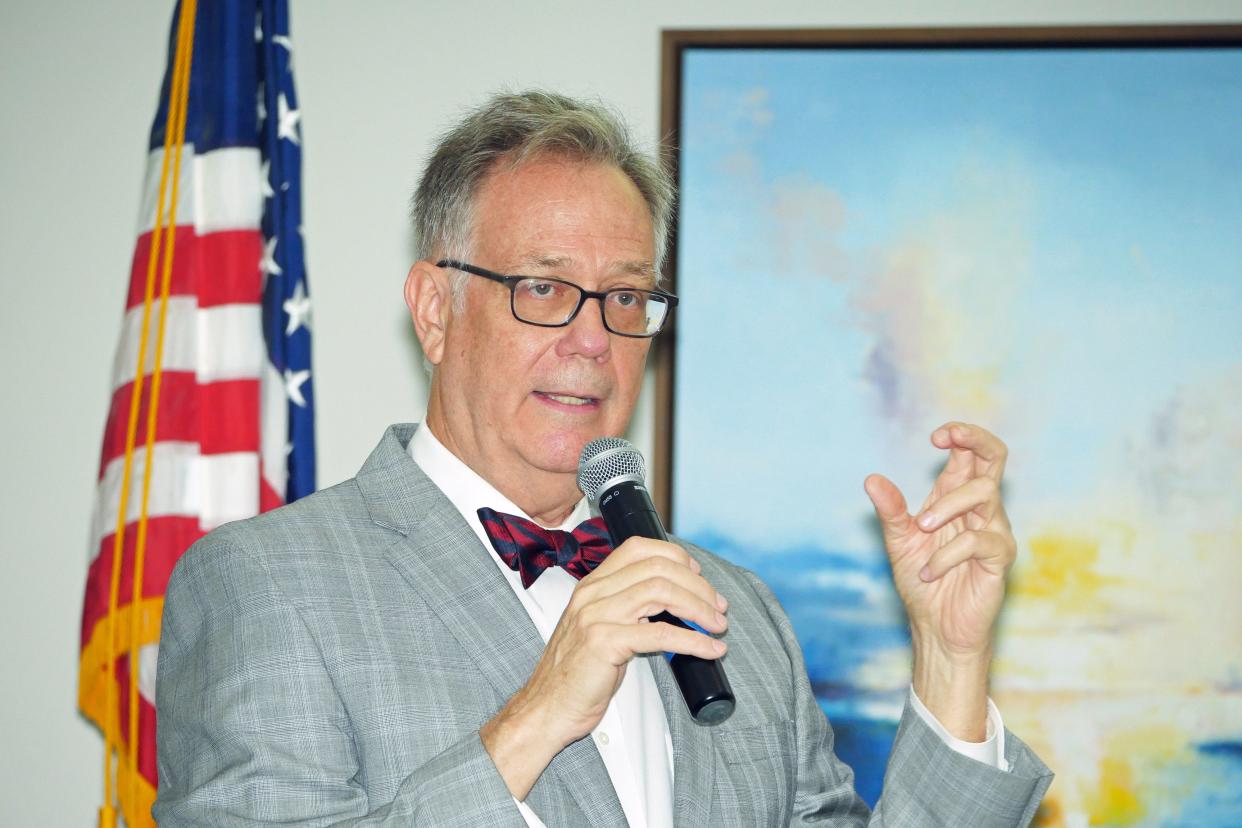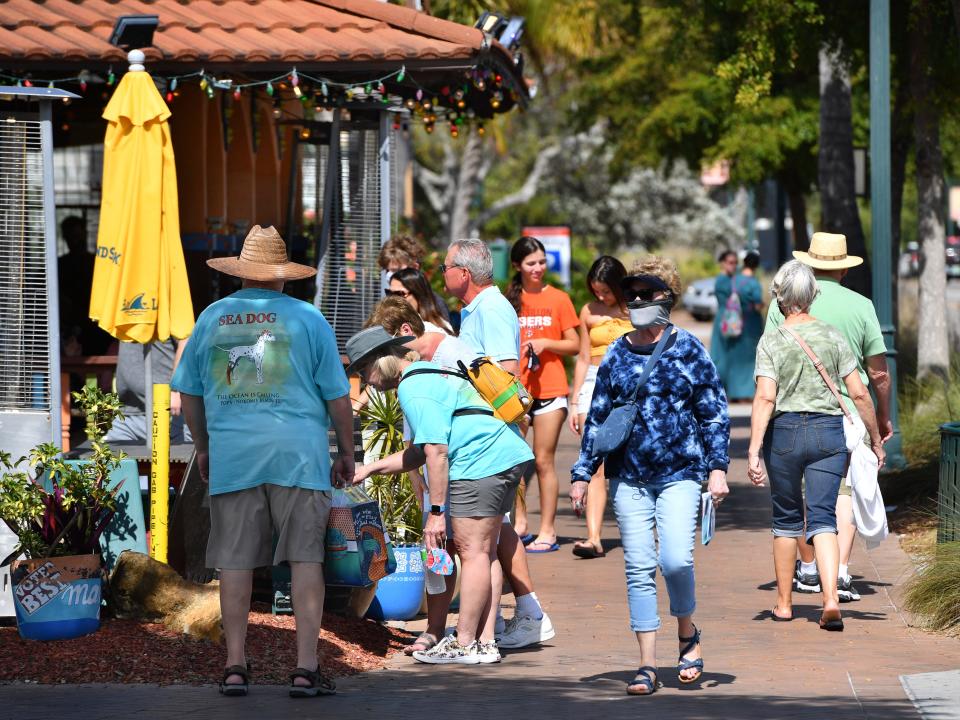FSU economist says recession possible in 2023

VENICE – Florida in general and the North Port-Sarasota-Bradenton metropolitan area specifically, have recovered from COVID-19 job losses more quickly than the rest of the country, Florida State University economist Jerry Parrish said Friday morning at the Venice Area Chamber of Commerce 2022 Economic Outlook breakfast.
Parrish was cautiously optimistic about the economic future, but said a recession appears likely by early 2023, though it would be different from the Great Recession, which was driven by a protracted housing crisis.
Earlier: Florida Chamber economist sees migration rising, recession risks dropping
Cost of living: Housing affordability crisis will be 'drag' on Florida's economy, expert says
“The probability of us going into a recession in 2023 is high and it's climbing,” Parrish said. “It doesn’t mean it’s going to be a bad recession; the big difference in this one and the last one is credit quality – we didn’t have a bunch of people getting liars’ loans, getting houses that they couldn’t afford, and throwing a bunch of property into turmoil and on the market.
“Even if we do have a recession in the U.S. level it doesn’t mean we’ll have one in Florida,” he added. “However, the probability of the Fed (Federal Reserve System) engineering a soft landing and making this super easy and super smooth is very, very difficult when inflation is running at 8%.”
He urged attendees to watch the Federal Reserve and interest rates; gasoline, natural gas and food prices; and the probability of a recession. But that was at the end of the program.
Parrish, an in-demand economist who, among other roles, previously served as the chief economist for the Florida Chamber of Commerce, started by highlighting how Florida, which lost almost 435,000 jobs in 2020 because of COVID-19, gained more than 523,000 in 2021.
In all, it took 20 months – from the low point of Febrary 2020 to the high point of October 2021 – for Florida to rebound, in terms of the number of jobs, Parrish noted. He said that in the North Port-Sarasota-Bradenton area, that recovery occurred in June 2021.
But, according to the Bureau of Labor Statistics, the leisure and hospitality and education and health services sectors – which are grouped together by the bureau – have still not recovered.
“Education services have recovered but health care has not,” he added, citing nurses who left the profession during the recession.
While leisure and hospitality jobs typically account for 14.4% of jobs in Sarasota County but produce only 7.3% of the wages generated, Parrish stressed that they’re important first jobs, for people to learn how to be a good employee.
Importance of out-of-state visitors
Parrish also detailed the importance of tourism and out-of-state visitors to the state, which raises funds off of sales tax and user fees, since 6% of whatever is spent goes to Florida.
About 131.4 million visitors a year come to Florida, including more than 14 million international visitors.
“They stay longer and they spend more,” Parrish said.
About $5 billion in state taxes are generated by out-of-state visitors and almost as much in county tax revenue, he added.
Still, Florida’s rebound came without the benefit of most of those 14 million international visitors, he noted.
International visitation was down 90% post COVID-19, Parrish said, then added that year-over-year visits from Canada were down more than 99%, since those travelers didn’t want to spend two weeks in a quarantine hotel after returning home.
Visitors flying in: Sarasota-Bradenton airport tops 1 million passengers already this year
Life after work: Sarasota, yet again, is the best place to retire in the U.S.

From 2015 until the start of the COVID-19 pandemic, Florida represented about one-twentieth of the country’s economy but created one out of every 11 new jobs, an indication that the state was punching above its weight class.
“When the international travelers come back, wow, it's going to be bonus time in the state of Florida,” Parrish said.
In touching on the growth of gross domestic product from 2011 to 2021, Parrish noted that Florida’s growth rate of 62.4% eclipsed the U.S. rate of 47.4%.
Overall, Florida’s GDP is $1.1 trillion, while Sarasota County’s is $22.9 billion.
From 2012 to 2020, according to the U.S. Bureau of Economic Analysis, Florida’s GDP growth was 42.1%, with Sarasota County’s noted at 61.3%.
“That means you guys are growing high value jobs,” Parrish said.
Remote work helps fuel recovery
The post COVID-19 recovery was partly fueled by both an influx of domestic visitors spending more time in second homes and remote workers moving to the state.
Referencing the web site https://www.howmoneywalks.com, which tracks the movement of wealth using IRS data, talked about an income migration to Sarasota County specifically of $1.94 million per day.
For the period 1992 to 2019, he noted that Sarasota County gained $425.5 million in income from Cook County, Illinois; $273.4 million from Fairfield, Connecticut; $253 million from Oakland, Michigan; $206.1 million from Westchester, New York; and $195.3 million from Fairfax, Virginia.
Conversely, the county lost $217.8 million to Manatee County, $22.5 million to Sumter County, $18.6 million to Buncombe County, North Carolina, where Asheville is located; $15.4 million to Duval County; and $14.5 million to Marion County.
Urban appeal: Downtown Sarasota drawing more buyers for lifestyle, amenities
The Futurist: The collapse of legacy thinking about the workplace
Some of that outflow, to places like Sumter and Marion counties, he said, can be attributed to people retiring from this area and moving to The Villages.
“A lot of counties, they get most of their wealth from inside Florida,” Parrish said. “Think about this $1.94 million of adjusted income moves into this area every day. That’s why you guys have recovered so quickly.”
Parrish also talked about how Florida will benefit from a bifurcated economy, with remote workers opting to live in a relatively lower cost state with no income tax.
Florida in general was the eighth fastest growing state in the country between the 2010 and 2020 census, adding 2.73 million people – second only to Texas – for a 14.6% growth rate.
Overally, the U.S. population grew 7.4% during the census period.
Sarasota County’s 14.4% growth rate tracked closely to the state’s growth rate, Parrish said, but 17 rural Florida counties lost population during that time period – with those who can move doing so for better opportunities.
COVID-19 did spur an increase in population to some Florida rural counties, Parrish said.
The next 4 million people
Referencing University of Florida’s Bureau of Economic & Business Research projections for where Florida’s next 4 million people will live, the state’s most populous counties –Miami-Dade, Orange, Hillsborough and Broward – are projected to add more than 1.51 million people.
Sarasota is projected to add another 84,400 people, 18.7% growth.
That 4 million mark could come as soon as 2035, Parrish said but he pointed to a group of Panhandle counties as possibly out-performing the projected rates, due in part to a commitment to add high-speed internet.
Earlier this month, the Tri-County Electric Cooperative announced plans to extend fiber to 12,000 to 15,000 homes and businesses in Jefferson, Madison, Taylor and Dixie counties.
That would be the first project in the state launched by an electric cooperative.
Parrish noted that when Florida chambers field calls from prospective residents, the availability of high speed internet is one of first questions asked – after queries about the quality of the schools.
“Think about what’s going on in the labor market, remember I said it was bifurcating,” Parrish said. “People that can work from anywhere in the country now have market power that they never had before and they don’t have those commuting costs.”
He added that companies are likely to allow super-productive workers to work from home.
At the same time, he added, “That worker you have that can work from home, some California company can call them and offer them a California salary to work from home in Florida.”
Parrish raised some concerns, notably about consumer sentiment, with inflation prompting a more pessimistic view than even during the COVID-19 pandemic.
Economic uncertainty ranging from concern over inflation to the war in the Ukraine impacts that confidence level.
He was more optimistic about whether the increased cost of housing was creating a housing bubble that would burst.
“Is there a housing bubble? I’m not buying it,” Parrish said.
Instead, he said that “what we do expect is the rate of increase is going to taper off, and fairly quickly.”
Earle Kimel primarily covers south Sarasota County for the Herald-Tribune and can be reached at earle.kimel@heraldtribune.com. Support local journalism with a digital subscription to the Herald-Tribune.
This article originally appeared on Sarasota Herald-Tribune: Florida economy: FSU economist details state's recovery from COVID pandemic

